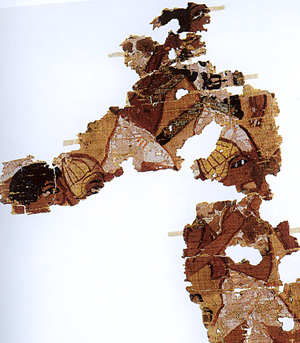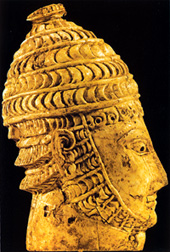Skip to comments.
The Greek Age of Bronze -- Middle Helmets
http://www.salimbeti.com/micenei/helmets2.htm ^
Posted on 04/24/2014 8:56:17 AM PDT by SunkenCiv
Outside the Greek mainland and Aegean Island a possible representation of Achaean warriors equipped with boar tusks helmets is from an Egyptian papyrus fragments from Tell el-Amarna, home of Amenhotep III's son, dated around 1350 BC (*2). In this papyrus some warriors are depicted with conical pale-yellow helmets which remaind in general design the typical Aegean boar tusks helmet.
This identification is strengthened by the find of a piece of boar’s tusk, with perforations for attaching it to a leather frame, during excavations at Qantir, the site of the Ramesside capital Pi-ramesse in the eastern delta. It appears likely that this piece was part of the famous boar’stusk helmets worn by the Achaean elite.
These elements and the recent discovery in Kanakia, Salaminas island of a corselet bronze scale with the stamp of pharaoh Ramesses II (see the page dedicated to the scale armour) are clear evidences that Achaean mercenaries have been on duty in the Egyptian troops in different periods.
(Excerpt) Read more at salimbeti.com ...
TOPICS: Astronomy; History; Science; Travel
KEYWORDS: 1177bc; 18thdynasty; 19thdynasty; 22nddynasty; 26thdynasty; akhenaten; amarna; amenhotepiii; bronzeage; catastrophism; egypt; ericcline; erichcline; ethiopiandynasty; godsgravesglyphs; greeks; libyandynasty; medinethabu; mycenaean; mycenaeans; peleset; pereset; qantir; ramsesii; ramsesiii; seapeople; seapeoples; thebandynasty; trojanwar
2. The British Museum has acquired some 40 fragments of a painted papyrus from Amarna (inv. no. EA 74100) with a unique representation of a battle. It was found in 1936 in a building which was probably a chapel dedicated to the cult of a king. The battle scene is preserved in two main areas. The first scene shows a group of Libyan archers attacking an Egyptian, while the second shows a group of running warriors, arranged in two overlapping registers. There is a very fragmentary third scene with similar figures. All the soldiers wear white kilts typical of Egyptian troops. Some wear helmet similar to Egyptian representation of gurpisu helmets worn by Asiatics. These helmets may actually have represented Achaean boar's tusk helmets. Some of the soldiers wear oxhide tunics which may have been lined with metal strips. This too is compatible with Achaean depictions of warriors.

1
posted on
04/24/2014 8:56:17 AM PDT
by
SunkenCiv
Read reference to it
here, in Barry Straus' book on the Trojan War (which is otherwise not all that great, imho).
2
posted on
04/24/2014 8:59:52 AM PDT
by
SunkenCiv
(https://secure.freerepublic.com/donate/)
Of helmets and heretics:
a possible Egyptian representation of Mycenaean warriors on a papyrus from el-Amarna
L. Schofield and R. B. Parkinson
http://journals.cambridge.org/action/displayAbstract?fromPage=online&aid=8533134
The Egyptian Interest in Mycenaean Greecemore
by Jorrit Kelder
https://www.academia.edu/221955/The_Egyptian_Interest_in_Mycenaean_Greece
lvo ry and related materials
oLCA KRZYSZKowSKA RoBERT MoRKor
https://ore.exeter.ac.uk/repository/bitstream/handle/10036/33752/ivory.pdf?sequence=1
Evidence for the Mycenaean Age Paralleling the El Amarna Age
http://www.freerepublic.com/perl/post?id=3148139%2C0
This evidence is based on papyrus fragments found by Pendlebury in 1936 in House R 43:2 when he wrote, “finds in this building included a complete Mycenaean vase (the second complete example found on the site) and a number of fragments of papyrus - still awaiting a proper treatment.’ This treatment was accomplished by Bridget Leach (Conservation Department of the British Museum). All the fragments of the painted papyrus portion have now been positioned with reasonable certainty. They show 3 accumulations of small fragments (right to left) as part of a battle scene, a) `Libyan archers are depicted attacking a fallen Egyptian in a rocky terrain’; b) the middle scene shows running troops and an archer shooting an arrow; c) running foot soldiers. The significance of these scenes is that they show the unusual feature of a type of helmet on some of the running troops which are said to be remarkably similar to boar tusk helmets as found in Mycenaean images. One of the helmeted figures is also interpreted to wear a cropped ox-hide tunic which also has Aegean parallels.[2100]
3
posted on
04/24/2014 9:02:52 AM PDT
by
SunkenCiv
(https://secure.freerepublic.com/donate/)
4
posted on
04/24/2014 9:09:45 AM PDT
by
SunkenCiv
(https://secure.freerepublic.com/donate/)
To: 75thOVI; agrace; aimhigh; Alice in Wonderland; AndrewC; aragorn; aristotleman; Avoiding_Sulla; ...
One of *those* topics, bigtime.
5
posted on
04/24/2014 9:09:58 AM PDT
by
SunkenCiv
(https://secure.freerepublic.com/donate/)
To: StayAt HomeMother; Ernest_at_the_Beach; decimon; 1010RD; 21twelve; 24Karet; 2ndDivisionVet; ...
6
posted on
04/24/2014 9:10:08 AM PDT
by
SunkenCiv
(https://secure.freerepublic.com/donate/)
7
posted on
04/24/2014 9:16:47 AM PDT
by
SunkenCiv
(https://secure.freerepublic.com/donate/)
To: SunkenCiv
gurpisu helmets: New to me -- and also unknown on the internet apparently
Achaean boar's tusk helmets.

8
posted on
04/24/2014 11:12:24 AM PDT
by
BenLurkin
(This is not a statement of fact. It is either opinion or satire; or both.)
To: SunkenCiv
I had wondered whether archaic helmets used helmet liners or some kind of suspension. Never see academics addresss that in the popular media.
Cannot picture our ancestors just plunking the metal hats unsupported onto theirv noggins.
9
posted on
04/24/2014 11:47:05 AM PDT
by
Rockpile
To: Rockpile
It would have to have been leather to stand up to the punishment. Of course, they fought until they died, fell down, or ran away, unless the two sides just got tired.
10
posted on
04/24/2014 12:58:57 PM PDT
by
SunkenCiv
(https://secure.freerepublic.com/donate/)
To: BenLurkin
When someone sez gurpisu, I’m inclined to say gesundheit.
11
posted on
04/24/2014 12:59:11 PM PDT
by
SunkenCiv
(https://secure.freerepublic.com/donate/)
To: SunkenCiv
That is a dandy website you linked to.
BTW, I never thought of them using felt as padding for the linings.
12
posted on
04/24/2014 2:51:34 PM PDT
by
Rockpile
To: Rockpile
My pleasure, which one of the websites?
13
posted on
04/24/2014 3:07:15 PM PDT
by
SunkenCiv
(https://secure.freerepublic.com/donate/)
To: SunkenCiv
14
posted on
04/24/2014 8:49:32 PM PDT
by
Rockpile
To: SunkenCiv; All
I have long thought that as Crete fell into eclipse after its maritime strength was destroyed by tsunamis from Thera, that artists and artisans may have made there way to Egypt and more specifically Amarna. In addition I imagine that mainland Greeks also made their way to Crete and thence to Egypt. There was definitely commerce between the two.
To: gleeaikin
The commerce happened because of ships, not tsunamis — and not least because there were none from Santorini.
16
posted on
04/27/2014 11:32:06 AM PDT
by
SunkenCiv
(https://secure.freerepublic.com/donate/)
To: Rockpile
It looks worth exploring, maybe there are more topics lurking in there.
17
posted on
04/27/2014 11:32:37 AM PDT
by
SunkenCiv
(https://secure.freerepublic.com/donate/)
Disclaimer:
Opinions posted on Free Republic are those of the individual
posters and do not necessarily represent the opinion of Free Republic or its
management. All materials posted herein are protected by copyright law and the
exemption for fair use of copyrighted works.
FreeRepublic.com is powered by software copyright 2000-2008 John Robinson



